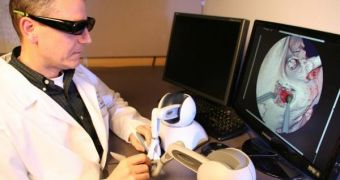When new airline pilots are being trained, they are not placed inside the cockpit as soon as they finish basic training. They spend hundreds of hours in simulators, learning all possible aspects of the plane, and how it could fail, and are given a plane after they know the machine inside out. However, in the case of surgeons, their first surgeries are done directly on patients, which can have harmful consequences for both the doctor and the person on the table. With that in mind, scientists have now devised simulators that allow surgeons to practice without the risk of harming anyone, Wired informs.
Essentially, the idea behind these instruments is to remove trial-by-error from the operating rooms around the world. The way experts imagine doing so is with virtual reality, in which the young surgeons work on models and animations before moving on to do their jobs on actual patients. “You can imagine in aviation if a copilot just sat there watching what the pilot did, and then did a couple of little things here and there. I don’t think the passengers would feel very confident when he was given his first plane to fly,” says Dilworth Cannon, who is an orthopedic surgeon at the University of California in San Francisco (UCSF).
The expert adds that there is no viable replacement for the “see one, do one, teach one” approach on medical training at this point. Nobody would like to be the patient on whom a first-time surgeon operates, or even the patient on whom an experienced surgeon tries out a new procedure. As it stands, until now, there has been no other option. In spite of the fact that the idea of virtual simulations in surgery has been around for decades, it was only recently that the technology became complex and cheap enough to be considered as a viable option.
Training on dead bodies is also a widely used method, but the problem is that not many suitable specimens can be found, so that all students get a chance to practice. “You might be lucky to get two or three procedures out of a cadaver. With virtual reality simulators, you can keep using them over and over,” Cannon explains. The newly developed simulator that some surgeons have had the opportunity to test consists of a mannequin head and an endoscope, together with a computer and special goggles.
“In the past, devices were extremely expensive and extremely cumbersome. But now with the availability of commercial devices, these kinds of systems can be put on an average desktop or operating room and can be used by whoever needs it whenever they want it,” says Stanford University School of Medicine surgeon Nikolas Blevins. He is the co-author of a new scientific paper presenting the simulators, published in this month's issue of the Journal of Rhinology and Allergy.
Video: A view inside the sinus cavity using Stanford’s simulator Credits: SensAble Technologies.

 14 DAY TRIAL //
14 DAY TRIAL //